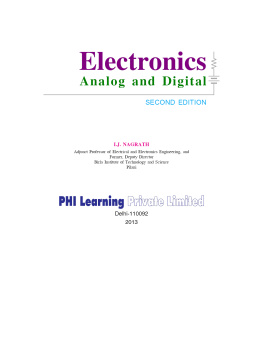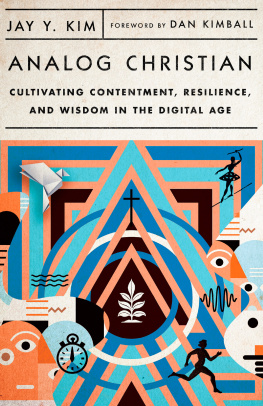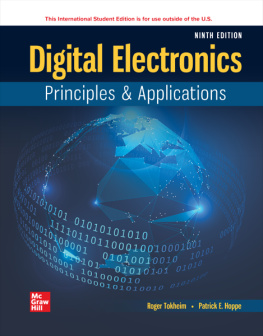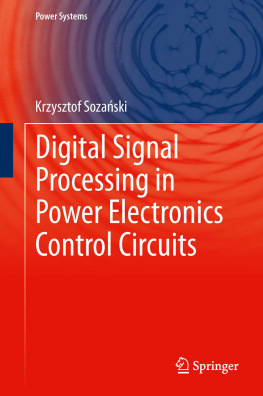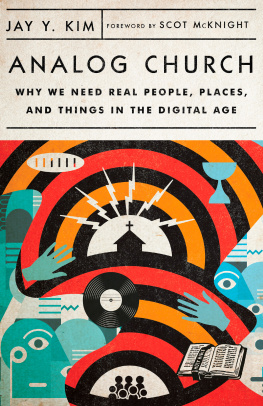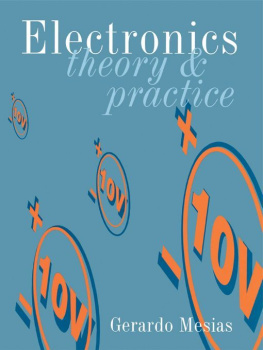Nagrath - Electronics: Analog and Digital
Here you can read online Nagrath - Electronics: Analog and Digital full text of the book (entire story) in english for free. Download pdf and epub, get meaning, cover and reviews about this ebook. year: 2013, genre: Home and family. Description of the work, (preface) as well as reviews are available. Best literature library LitArk.com created for fans of good reading and offers a wide selection of genres:
Romance novel
Science fiction
Adventure
Detective
Science
History
Home and family
Prose
Art
Politics
Computer
Non-fiction
Religion
Business
Children
Humor
Choose a favorite category and find really read worthwhile books. Enjoy immersion in the world of imagination, feel the emotions of the characters or learn something new for yourself, make an fascinating discovery.
- Book:Electronics: Analog and Digital
- Author:
- Genre:
- Year:2013
- Rating:5 / 5
- Favourites:Add to favourites
- Your mark:
- 100
- 1
- 2
- 3
- 4
- 5
Electronics: Analog and Digital: summary, description and annotation
We offer to read an annotation, description, summary or preface (depends on what the author of the book "Electronics: Analog and Digital" wrote himself). If you haven't found the necessary information about the book — write in the comments, we will try to find it.
Electronics: Analog and Digital — read online for free the complete book (whole text) full work
Below is the text of the book, divided by pages. System saving the place of the last page read, allows you to conveniently read the book "Electronics: Analog and Digital" online for free, without having to search again every time where you left off. Put a bookmark, and you can go to the page where you finished reading at any time.
Font size:
Interval:
Bookmark:

I.J. NAGRATH
Adjunct Professor of Electrical and Electronics Engineering, and
Former, Deputy Director
Birla Institute of Technology and Science
Pilani

Delhi-110092
2013
ELECTRONICS: Analog and Digital, Second Edition
I.J. Nagrath
2013 by PHI Learning Private Limited, Delhi. All rights reserved. No part of this book may be reproduced in any form, by mimeograph or any other means, without permission in writing from the publisher.
ISBN-978-81-203-4802-8
The export rights of this book are vested solely with the publisher.
Twelfth Printing (Second Edition) ... ... ... November, 2013
Published by Asoke K. Ghosh, PHI Learning Private Limited, Rimjhim House, 111, Patparganj Industrial Estate, Delhi -110092 and Printed by Rajkamal Electric Press, Plot No. 2, Phase IV, HSIDC, Kundli-131028, Sonepat, Haryana.

Over the years, based on the readers response and feedback, both the author and the publisher felt the need to update the text and to bring out the second edition of the book including the recent developments in the subject.
In this edition, the chapters on digital electronics have been updated and enlarged, in particular. However, necessary improvements have been made in the analog part as well.
Chapter 1 on semiconductors, now in its second edition, includes Halls effect and some improvement in diode, rectifiers and the transfer characteristics of MOS devices now include a problem on graphical analysis.
In small-signal model of BJT, clarity has been brought in dc and ac . Hybrid- model has been elaborated. Stress has been laid on h -parameter model for completeness and also it has been compared with the - r model. Biasing stability has been examined for both types of transistors and self-bias potential divider bias is recommended. Further, explanation for CB configuration has been advanced leading to r e model. Another additional feature is the emitter coupled pair (differential pair), which builds the background for OPAMP.
Unique treatment of frequency response of small-signal amplifiers holds the competition.
Power amplifiers have been introduced with the added feature of Class D. Completeness and completion of oscillators can still not be matched by many others.
In operational Amplifiers (OPAMP), the gain of difference mode and common mode leading to CMRR is made simple and straightforward. All applicationslinear and nonlinear are treated in detail.
Improvements in digital part
Chapter 8 has been introduced with buffer, glitches and strobes.
- Digital pulse response of various gates gives a clear picture of gate outputs.
- Digital logic families is now complete.
- Hardware design of gates continues to be a strong feature.
Chapter 9 begins with number systemsdecimal, binary, octal and hexadecimal, their inter- conversions and arithmetic, Codesbinary and ASCII, use of 1-compliment, 2-compliment and subtraction by 2-compliment.
Boolean relations, sum of products (sop) and product-of-sums (pos) methods, Karnaugh maps simplification and Quine McCluskey method of simplification have been updated.
Adders and subtractorshalf adder (HA) and full adder (FA), Principle of addition and subtraction by XOR gates and additionsubtraction complete system, which takes 2-compliment if the answer is negative, have been explained. As per my knowledge, this is perhaps the only book which presents the complete system.
Other combinational circuits are covered including comparator, parity checkers, multiplexer, demultiplexers, coders, decoders. Programmables arrays (PLAs) have been included in the chapter.
New examples and problems have been added at appropriate places.
Chapter 10Sequential Circuits and Systems.
This is the most updated and enlarged chapter. Each topic presents truth tables, proof, symbol and waveforms. Wherever required, manufacturers number, pinout and logic diagram are given which is unique in presentation.
Each topic includes new examples and problems at the end.
Flip-Flops (FFs)
The topic begins with basic memory cell to store 1/0. It then goes on to SR flip flop (FF) and clocked SR FF circuits, types of trigger-level and pulse, preset and clear enteries, pulse triggering-clock serial, positive edge triggering (0 to 1) (PT) and negative edge triggering (1 to 0) (NT). The gate circuits for generating PT and NT are presented.
The circuits and truth tables of PT/NT triggered SR FF have been advanced. Waveforms of clock, SR and Q are shown.
Converting SR FF to JK FF circuit and truth table proof with their advantages are given. It is followed by Master-Slave JK FF circuit.
Converting SR and JK to D and T flip flops have been explained.
Excitation table for all flip-flops has been includedmostly useful in the circuits composed of FFs. The state synthesis table for converting SR to JK, FFs based on excitation table is presented.
Registers
The registers, which store and manipulate data, of all four typesSISO, SIPO, PIPO, PISOare operationally explained through one diagram with their applications. Bidirectional shift circuits are shown and commercially available registers are listed.
With the help of an example of parallel in-serial-out, TTL54/7465, 8 bits, operation of a register is explained supported with a separately drawn control diagram.
Counters
Both asynchronous and synchronous counters designs are presented through triggering truth tables and UP/DOWN counters. Advantage of synchronous counters have been clarified. Non-binary and BCD counters have been explained in detailMOD-3, MOD-6 = MOD-3 2, MOD-5 and MOD10 = MOD2 5; binary and biquinary counts.
Also, presettable synchronous counter have been introduced and ring counters and twisted ring counters have been included.
State diagrams
Moore and Mealy models, supported with several examples, are put forward to arrive at logic diagram through state models.
Memory
All aspects of memory organization are presented in detail with circuitry.
ROM (read only memory), shown to be nonvolatile, has been addressed. It can be bipolar. MOS and CMOS both types are programmable but MOS can be erased and reprogrammed. For large data, magnetic and optical memories the common feature now. These cannot be addressed but have to be read sequentially. All aspects and devices such as tape, hard disk and floppy are explained followed by ROM (electronic), using diodes BJT and MOS. These are shown to be nonvolatile.
Two dimensional (X, Y) addressing of a ROM is explained with diagrams which is faster and shown to need smaller number of NANDs Word and bit expansion is explained with examples.
These techniques are equally applicable to RAMs.
In Random Access Memory (RAM), it is shown that any memory cell can be read and written, but the memory is volatile. RAM organization is fully explained with the help of figurestwo dimensional addressing etc. Bipolar RAM, which can be static only, is presented through detailed diagram of one cell with all controls. Then follows the connection diagram of static NMOS RAM.
Font size:
Interval:
Bookmark:
Similar books «Electronics: Analog and Digital»
Look at similar books to Electronics: Analog and Digital. We have selected literature similar in name and meaning in the hope of providing readers with more options to find new, interesting, not yet read works.
Discussion, reviews of the book Electronics: Analog and Digital and just readers' own opinions. Leave your comments, write what you think about the work, its meaning or the main characters. Specify what exactly you liked and what you didn't like, and why you think so.

